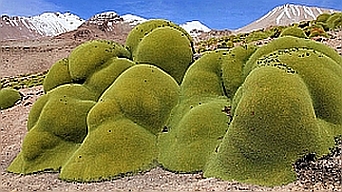Jabalitika

The windswept, arid heights of Mlima-Wa-Moto support little life. The plants that grow there are small and tough. An aggressive, burrowing species of large wingless wasp crawls around, its mottled hair-like covering allowing it blend in with the terrain, providing camoflauge against the shaggy-furred rock badgers that feed almost exclusively on the insects. As for the wasps themselves, they survive on sticky umande, the jabalitika’s dewy excretion.
The jabalitika grows lichen-like on rocks. This strange plant has a rapid growth cycle. Spores take root in a rock’s tiny fissures and quickly mature, spreading over several square feet in just a few days. A mature jabalitika has a thickness of about one-quarter inch (or 0.635 centimeters). Via enzymes, the jabalitika converts minute quanities of the rock’s surface into a micro-stew of minerals and water that the plant uses to survive. Of course, being a plant, the jabalitika also engages in photosynthesis. The aforementioned dew-like excretion, or umande, is a waste product of the jabalitika.
Umande is highly nutritious but slightly punguent. A half-pint (about a quarter of a liter) provides sufficient nutrition for an adult human for a full day. Umande also increases the efficiency of respiratory systems in animals, making it easier to breathe Mlima-Wa-Moto’s thin, high-altitude air. A square foot (a bit more than 900 square centimeters) of jabalitika produces about a half-pint of umande under optimal conditions.
The rugged mountain people of Mlima-Wa-Moto cultivate jabalitika to harvest umande. They domestic rock badgers to help keep their jabalitika fields as free of wingless wasps as possible. While those insects are not especially dangerous, their stings are extremely painful, capable of incapacitating a grown man for several minutes.

Leave a Reply